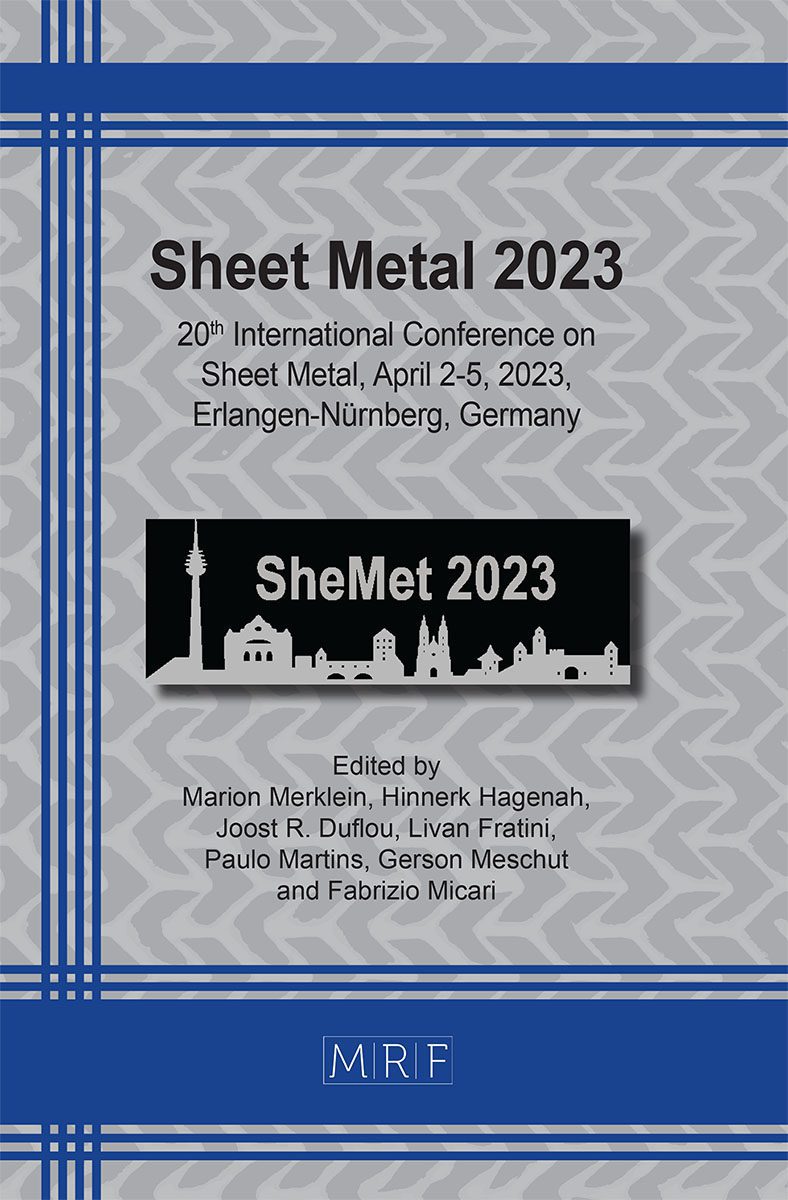Investigation on pin caulking as a versatile joining process
David Römisch, Marion Merklein
download PDFAbstract. Lightweight design is increasingly used to combine the specific advantages of various dissimilar materials into multi-material systems. The aim is to make production more resource-efficient and reduce emissions. However, one challenge in the adaptation of multi-material systems is the lack of versatile joining technologies capable of joining these materials. Joining with cold formed pins is a two-step process with potential in joining metal to metal and metal to fibre-reinforced plastics (FRP). These pins can be joined using two joining strategies, direct pin pressing into an unperforated joining partner and caulking of pins, which are inserted through a pre-punched joining partner. For pin pressing, several studies have already been carried out regarding joinability of steel and aluminium, but caulking offers advantages such as a reduced joining force and the fact that the pin can transmit force over the entire sheet thickness of the joining partner, which can lead to increased strength under axial load. Therefore, the caulking of pins extruded from dual-phase steel with a 6000 aluminium alloy is investigated. The focus is on a fundamental investigation of the joining process and the joint formation when caulking pins of varying heights with sheets of different thicknesses. Subsequently, a process window is derived from these findings.
Keywords
Joining, Metal, Pin Caulking
Published online 3/17/2023, 8 pages
Copyright © 2023 by the author(s)
Published under license by Materials Research Forum LLC., Millersville PA, USA
Citation: David Römisch, Marion Merklein, Investigation on pin caulking as a versatile joining process, Materials Research Proceedings, Vol. 25, pp 109-116, 2023
DOI: https://doi.org/10.21741/9781644902417-14
The article was published as article 14 of the book Sheet Metal 2023
![]() Content from this work may be used under the terms of the Creative Commons Attribution 3.0 licence. Any further distribution of this work must maintain attribution to the author(s) and the title of the work, journal citation and DOI.
Content from this work may be used under the terms of the Creative Commons Attribution 3.0 licence. Any further distribution of this work must maintain attribution to the author(s) and the title of the work, journal citation and DOI.
References
[1] Eurostat, Greenhouse gas emissions by source sector. https://ec.europa.eu/eurostat/databrowser/bookmark/1ffd5837-18ba-4e68-9634-1eaf2d6d4023?lang=de (accessed 2022.09.21).
[2] G. Meschut, M. Merklein, A. Brosius, D. Drummer, L. Fratini, U. Füssel, M. Gude, W. Homberg, P.A.F. Martins, M. Bobbert, M. Lechner, R. Kupfer, B. Gröger, D. Han, J. Kalich, F. Kappe, T. Kleffel, D. Köhler, C.-M. Kuball, J. Popp, D. Römisch, J. Troschitz, C. Wischer, S. Wituschek, M. Wolf, Review on mechanical joining by plastic deformation, Journal of Advanced Joining Processes, 177 (504-506), 2022 100113. https://doi.org/10.1016/j.jajp.2022.100113
[3] P.N. Parkes, R. Butler, J. Meyer, A. de Oliveira, Static strength of metal-composite joints with penetrative reinforcement, Composite Structures, 118, 2014 250–256. https://doi.org/10.1016/j.compstruct.2014.07.019
[4] E.E. Feistauer, J.F. Santos, S.T. Amancio‐Filho, A review on direct assembly of through‐the‐thickness reinforced metal–polymer composite hybrid structures, Polym Eng Sci, 59 (4), 2019 661–674. https://doi.org/10.1002/pen.25022
[5] S. Ucsnik, M. Scheerer, S. Zaremba, D.H. Pahr, Experimental investigation of a novel hybrid metal–composite joining technology, Composites Part A: Applied Science and Manufacturing, 41 (3), 2010 369–374. https://doi.org/10.1016/j.compositesa.2009.11.003
[6] D. Römisch, M. Kraus, M. Merklein, Experimental Study on Joining by Forming of HCT590X + Z and EN-AW 6014 Sheets Using Cold Extruded Pin Structures, JMMP, 5 (1), 2021 25. https://doi.org/10.3390/jmmp5010025
[7] D. Römisch, J. Popp, D. Drummer, M. Merklein, Joining of CFRT-steel hybrid parts via hole-forming and subsequent pin caulking, Production Engineering, 2021. https://doi.org/10.1007/s11740-021-01093-9
[8] Salzgitter Flachstahl GmbH, Data sheet – HCT590X+Z (HCT600XD / HC340XD*/ CR330Y590T-DP**), 2017. https://www.salzgitter-flachstahl.de/fileadmin/footage/MEDIA/gesellschaften/szfg/informationsmaterial/produktinformationen/feuerverzinkte_produkte/deu/hct590x.pdf (accessed 2022.10.06).
[9] K. Hirota, Fabrication of micro-billet by sheet extrusion, Journal of Materials Processing Technology, 191 (1-3), 2007 283–287. https://doi.org/10.1016/j.jmatprotec.2007.03.024
[10] E. Ghassemali, M.J. Tan, A. Jarfors, S. Lim, Progressive microforming process: Towards the mass production of micro-parts using sheet metal, The International Journal of Advanced Manufacturing Technology, 66, 2012. https://doi.org/10.1007/s00170-012-4352-4































